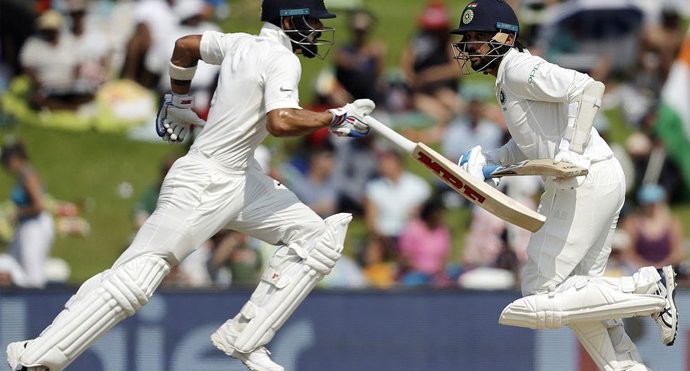
The hurt, as Virat Kohli himself said, is less in the defeat, than in the lack of fight.
-By Rahul Jayaram, Assistant Professor, Jindal School of Liberal Arts
If losing the Test series in South Africa – while working to disintegrate in a co-ordinated manner by running themselves out, throwing away wickets, dropping catches and making arbitrary selections – was the aim, then the Indian team, the coach, the captain, and the selection board must be lauded for their convincing effort.
In the midst of the synchronised batting breakdown at Centurion, Virat Kohli rose in even higher estimation as a batsman with his first innings century-and-a-half. Over five days, the Indian team trilled its way to another overseas Test series defeat against top opposition.
Like their ancestors from the 1980s and 1990s, this series defeat is going to psychologically sear a new generation of Indian Test cricketers. If the South African one-day international side has had the tag of “chokers” since readmission, the Indian Test team with one win in 24 Tests against top-flight opposition away from home since 2011, now adds renewed credence to the “tigers at home, lambs abroad” label. The hurt, as Virat Kohli himself said, is less in the defeat, than in the lack of fight. A few hours after the loss on day five, former Indian cricketer and cricket commentator Aakash Chopra, tweeted an oft-quoted chestnut from Benjamin Franklin: “By failing to prepare, you prepare to fail.” The Indian cricket board took that dictum to heart and proved itself unblemished in the enterprise.
When South African opener Dean Elgar battled Ravichandran Ashwin in the second innings as the Test match wore on, commentators reminded us of Ashwin’s words to Elgar when the Proteas toured India two years ago. “This is not Johannesburg,” Ashwin had then told Elgar. The loss at Centurion, on a wicket that was more Chepauk pancake than Centurion trampoline, may rub the loss further in. They lost on an Indian subcontinent-like surface, where they had mastered winning over the last two years.
One cannot fault India’s bowling (they took 20 wickets) as much as the batting. Across the two Tests so far, Virat Kohli was the only batsman to have played in a way that matched his standing. But as captain, he has to take the lion’s share of the blame for the defeat. He was confrontational in the post-match press interaction justifying his team selections. He was edgy when asked about India’s number one Test rank. (India remains on top even if they lose the thirst Test at the Wanderers, huh?)
Kohli the captain is not anywhere close to the zone of Kohli the batsman. How does he rationalise leaving out Ajinkya Rahane from the playing XI, the persisting with Rohit Sharma, the dropping of Bhuvneswar Kumar, and now, the temperament of Cheteshwar Pujara and to some extent even Murali Vijay? In non-subcontinental conditions, barring Kohli, each of India’s recognised Test batsmen, have individual problems of their own. The four batting innings so far have elicited their signature inadequacies. But in many ways, this series was lost even before a ball was bowled courtesy Messrs. Ravi Shastri and the team management that opted out of the lone practice game and was in any way hard-pressed for time to acclimatise. In effect, it’s hard not to see the Newlands Test being treated like a practice game. Sad, but true.
Ajinkya Rahane will be remembered for a long time for the way he did not play in this series. For the only batsman apart from Kohli who has had good Test scores in England, Australia, New Zealand and South Africa, Rahane’s non-selection has some parallels in Indian cricket history. Such decisions have had a devastating effect on a major tour.
In 1999-2000, Sachin Tendulkar’s team went to Australia without the experienced Mohammad Azharuddin. Barring hundreds from Tendulkar, VVS Laxman and a fifty from Sourav Ganguly, the tour was an infamous disaster. Rahul Dravid suffered the worst series of his career. Indian cricket was in disarray. Immediately after the tour, India played a two-Test home series against South Africa which it again lost, giving away its first home series in 14 years. Across the four innings, India had only one centurion: Mohammad Azharuddin. That performance in a losing Test and series, gave another push to the final stages of his international career. In some of the last remaining ODIs Azharuddin played in his last year as an international cricketer, he even racked up some man-of-the-match winning performances against teams like Pakistan.
In 2007-2008, Virender Sehwag was dropped for the first two Tests at Melbourne and Sydney (of “Monkeygate” infamy) and India lost them both. He returned to make an impact as the opener in Perth (India won) and scored an abrasive fourth innings hundred at Adelaide in the final Test to save India the game. Now, that Adelaide Test and Sehwag’s (and Tendulkar’s) batting in it, shifted the momentum towards India for the rest of the games that followed. Although India lost the Test series, they had wrested the initiative and finished the series on a high. They won the ODI triangular series that followed, in Australia, for the first time. Both the Azharuddin and Sehwag exclusions, at different points in Indian Test cricket history, attested that there was rarely any replacement for batsmen credentialed with good scores in alien conditions. It makes the case for Rahane’s inclusion even stronger.
Perhaps, Kohli needs to acknowledge some of his limitations as a captain, not change teams so often, and trust players that have performed under pressure, away from home.
As an Indian Test cricket follower, one cannot but feel one has been taken for granted and misled. The pre-series TV ads were all about “hisaab ka badla” and they quickly gave way to “Fogg chal raha hai”. Revenge gave way to submission in the course of the Newlands defeat.
One could sense the Indian TV cricket commentators drift away from their initial positions like the ads. Sometimes, one feels, their proximity to Indian cricket blinds them from distanced criticism. Sanjay Manjrekar and Harsha Bhogle thought India had a “real chance” to win this series, given the bowling attack India now has. They took the batting for granted. They admitted later on how wrong they had been. Our master interpreters of the game misinterpreted India’s game.
How deluded it must be to be an Indian Test cricket fan. We carry the burden of so much overseas anguish. How rueful that a country of 1.2 billion, the nerve centre and financial centre of the sport is unable to create a team that can win in all conditions, against all oppositions, in the game’s hardest format, most of the time. It must hurt to still be called the world’s best Test team.
Should we honourably give it up?
(The article was originally published in Daily O)

